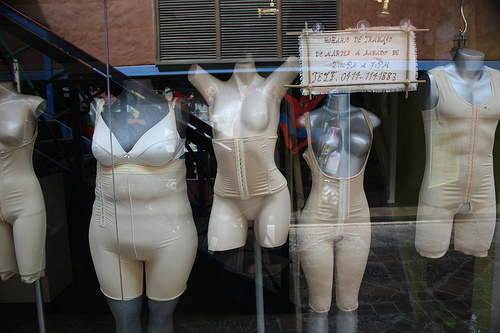In Defence of the Tailor: A Short Essay on Individuality

Photo by Liliana Amundaraín
In this era of unbridled individualism, it is ironic that tailors are disappearing from public life. They are our best instruments of customization and alteration, and our best hope for finding clothes that fit. Yet StatsCan reports that "the short-term outlook is gloomy," for tailors of all sorts, and the industry has sustained heavy losses since 2002. Tailors, with an average age of nearly 70, are literally dying off at an exponential rate.
This sartorial atrophy is killing our concept of personal style. Despite the rise of the i-everthing and pants with a "more custom fit" in the last few years, people have failed to become any more individual than they have been historically. Many products branded as custom or tailored are actually less unique than similar ones that would have been produced 50 years ago, and that same trend extends to all aspects of our consumer lives.
For example, the car manufacturer Scion says that "personalization, independent thinking and creativity are pillars of the brand philosophy," but options available in current models are only shadows of a bygone era. Car models from the 1960s commonly offered five different engines, more than ten different interior colour options, and three different transmissions. Likewise, pants made by tailors were not just a "tailored fit," but actually tailored and built around a customer's exact measurements.
After all, those measurements ultimately differentiate our bodies, the way we look, from other people. We consume in an effort to define our individuality, but by buying from the same stores, in the same sizes, we do nothing but degrade this individual quality. We would be more individual naked than if we all wore different-coloured, five-dollar t-shirts from H&M. Obviously, neither is likely or welcome, but I propose that well-tailored clothes are a happy medium.
Why we stopped using tailors is a complex riddle, and not one that I will be able to solve here. What we do know is that the consumption of ready-to-wear clothing has steadily increased since the war, spurred by cheaper labour abroad and relaxed trade laws. Regardless of the reason, shopping has changed completely during the last 50 years, and not always in a way that makes sense.
Men's dress shirts, which have changed very little over time, are now more expensive when marketed as "tailored," even if they aren't. Men's shirts have never been stylish when they look like the sails of a schooner; but they have traditionally been made big enough to accommodate a tailor's handiwork. Few realize that having any shirt altered to fit costs as little as $10. A man need only know his neck and chest measurements, buy a shirt that matches these, and have a tailor adjust it.
A good fit is the easiest thing to achieve with a tailor's help, but we have come to believe it is rare. We spend hours looking for ready-to-wear clothes that only approximate our bodies, instead of paying attention to the quality of their construction. The same principle applies to any kind of garment; whether you wear dresses, t-shirts, pants, or skirts, a tailor can save you hours of time and loads of money.
The fact is, tailors don't seem to have a place in contemporary fashion, and perhaps this comes back to their age. If I were handing over a shirt to a hip-looking twenty-something, I would feel confident; but these days I'm more likely to be asking a 70 year-old to make me look good. Maybe this is because sewing is becoming more and more foreign to us, the needle no more distant than a magic wand. But tailors spend all day, every day doing the kinds of simple measurements and fixes necessary to turn a bag into a bombshell.
Having your clothes fitted is also an enjoyable experience, a chance to interface with the materials you wear, and a person dedicated to making your clothes fit you. It is a flattering feeling to have someone take the time to make you look good, even if you are paying for it.
Tailoring used clothing is also environmentally friendly; unless people consume used clothes in Canada, they wind up in landfills or shipped overseas. In the US, a quarter of all pesticides applied go towards the production of new cotton. Cotton alternatives like polyester and nylon are petroleum-based, and require large amounts of crude oil to manufacture.
But I am not simply advocating that we all buy used clothing, or that we can save money and time by using tailors. Tailoring represents the value we place on the intrinsic individuality that is the birthright of every person. A tailor's work does not preclude an individual sense of style, but only enhance it.
There are few struggles as pointless as the one we fight for individuality. And this isn't because it is impossible to be unique, but because uniqueness is probably the only thing we never risk losing.
Related on maisonneuve.org:
—Old Masters
—Cast Off
—Clothespin Encounters
Subscribe - Follow Maisy on Twitter - Like Maisy on Facebook





